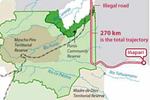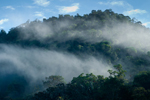Peru has delayed auctioning off 27 oil blocs in the Amazon in order to conduct legally-required consultations with indigenous groups in the region, reports the Guardian. Perupetro S.A., Peru’s state oil and gas company, has announced it will auction 9 blocs off the Pacific coast, but will hold auctioning off the controversial oil blocs in the Amazon rainforest at least until later this year.
The consultation comes after the Peruvian government approved a law in 2011 granting new rights to the nation’s indigenous peoples, including free, prior and informed consent (FPIC). According to the law, such groups must be consulted before any mining, logging, or oil and gas projects occur on their land. However, the law does not mean that such groups have the power to veto projects on their traditional lands.
Luis Ortiga Cuneo, chairman of Perupetro, told David Hill of the Guardian: “We’re identifying the communities we need to talk to. We haven’t talked to them yet, but we’re going to begin next month. We could be ready by the end of the year, but that will be difficult.”
The Peruvian government and indigenous people have a long history of tension and conflict over oil and other industrial project on their land. In 2009, 23 police officers and at least 10 indigenous protestors were killed when protests turned violent. Later, indigenous peoples alleged that bodies of protestors were thrown in rivers to hide the numbers killed.
This incident along with rising tensions across the Amazon added pressure to the Peruvian government to solidify indigenous rights. The new law was implemented by President Ollanta Humala a few month after he was sworn-in in July 2011, replacing Alan Garcia who was seen as obstructing indigenous rights.

Aerial view of the Peruvian Amazon. Photo by: Rhett A. Butler.
Related articles
Crazy cat numbers: unusually high jaguar densities discovered in the Amazon rainforest

(05/16/2013) Jaguars (Panthera onca) are the biggest cat in the Americas and the only member of the Panthera genus in the New World; an animal most people recognize, the jaguar is also the third largest cat in the world with an intoxicatingly dangerous beauty. The feline ranges from the harsh deserts of southern Arizona to the lush rainforests of Central America, and from the Pantanal wetlands all the way down to northern Argentina. These mega-predators stalk prey quietly through the grasses of Venezuelan savannas, prowl the Atlantic forests of eastern Brazil, hunt along the river of the Amazon, and even venture into lower parts of the Andes.
NGO: conflict of interests behind Peruvian highway proposal in the Amazon

(05/16/2013) As Peru’s legislature debates the merits of building the Purús highway through the Amazon rainforest, a new report by Global Witness alleges that the project has been aggressively pushed by those with a financial stake in opening up the remote area to logging and mining. Roads built in the Amazon lead to spikes in deforestation, mining, poaching and other extractive activities as remote areas become suddenly accessible. The road in question would cut through parts of the Peruvian Amazon rich in biodiversity and home to indigenous tribes who have chosen to live in “voluntary isolation.”
Is it possible to reduce the impact of oil drilling in the Amazon rainforest?

(05/02/2013) Oil extraction in the Amazon rainforest has been linked to severe environmental degradation — including deforestation and pollution — which in some areas has spurred violent social conflict. Yet a vast extent of the Colombian, Peruvian, Ecuadorian, Bolivian, and Brazilian Amazon is currently under concession for oil and gas exploration and production. It seems clear that much of this hydrocarbon development is going to proceed whether environmentalists and human rights groups like it or not.

(04/30/2013) When we think of conservation areas, many of us think of iconic National Parks overseen by uniformed government employees or wilderness areas purchased and run from afar by big-donor organizations like The Nature Conservancy, Wildlife Conservation Society, WWF, or Conservation International. But what happens to ecosystems and wildlife in areas where there’s a total lack of government presence and no money coming in for its protection? This is the story of one rural Peruvian community that took conservation matters into their own hands, with a little help from a dedicated pair of primate researchers, in order to protect a high biodiversity cloud forest.
Featured video: Earth Day message from indigenous tribes in the Peruvian Amazon
(04/23/2013) A new video by Alianza Arkana includes an Earth Day message from the indigenous peoples in the Peruvian Amazon who are facing the existential threats of logging and fossil fuel development on their traditional lands.

(03/26/2013) The Peruvian government has declared an environmental state of emergency after finding elevated levels of lead, barium, and chromium in the Pastaza River in the Amazon jungle, reports the Associated Press. Indigenous peoples in the area have been complaining for decades of widespread contamination from oil drilling, but this is the first time the Peruvian government has acknowledged their concerns. Currently 84 percent of the Peruvian Amazon is covered by potential oil blocs, leading to conflict with indigenous people and environmental degradation.